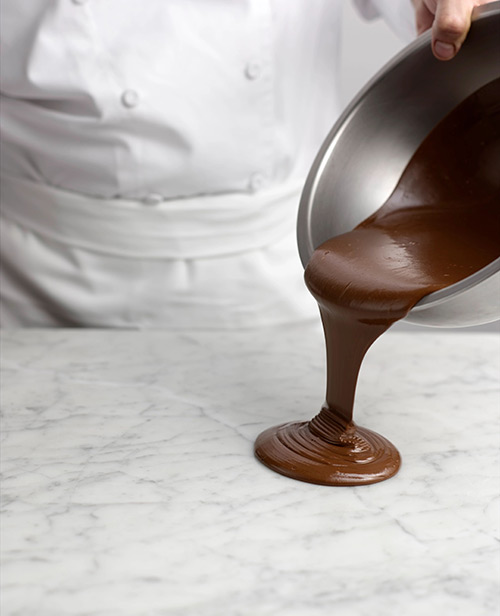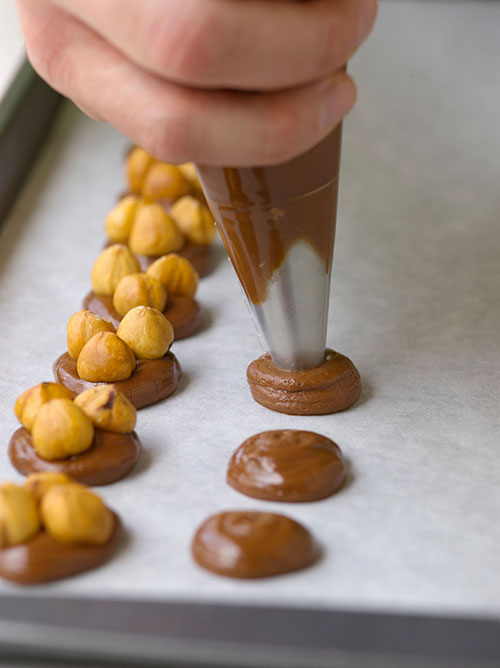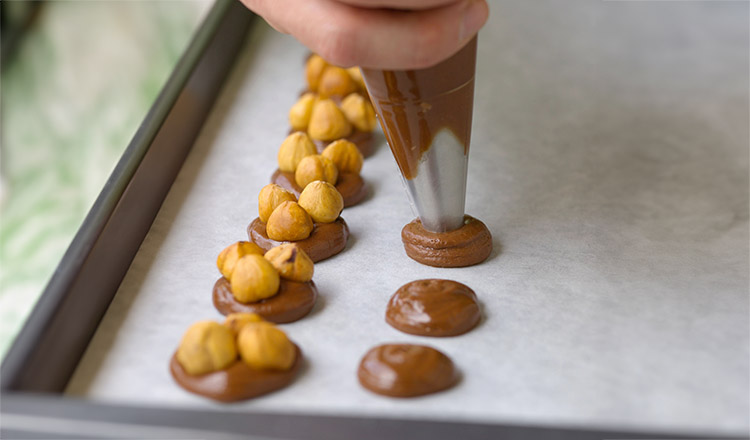Gianduja (jhan-DOO-ya) is a delicious mixture of chocolate and finely ground nuts. It is most likely Italian in origin and is traditionally made with dark chocolate and hazelnuts. While it is possible to toast and grind nuts and add the resulting paste to chocolate, it is simpler to make and smoother when a pre-ground nut butter is added to chocolate. Not only is this simpler, but it opens the door for many flavor combinations. Praline paste (made from hazelnuts) is the most frequently used nut paste in gianduja. At most grocery stores and online, you can find nut butters made from a variety of nuts. and any of them may also be used to create gianduja.
Because gianduja is high in cocoa butter from the chocolate, it requires tempering just as chocolate does, and for all of the same reasons. Untempered gianduja will not set quickly, will be soft, will have a grainy texture, and will bloom, just like untampered chocolate. There are different ways to temper gianduja, but for the recipes in this book the method is to begin with tempered chocolate, add the nut paste, and stir well to ensure that the gianduja will set properly.
What’s in it?
Gianduja contains chocolate (milk, dark, or white) and ground nuts, which may be any variety. It may also contain additional sugar. When sugar is added to gianduja in these recipes, confectioners’, not granulated, sugar is used for a smooth texture.
CHOCOLATE
Gianduja may be thought of as nut-flavored chocolate. When milk or white chocolate is used to make gianduja, slightly more chocolate is required to obtain the same fi mness from the product.
NUT PASTE
Almond butter or praline paste are the most traditional nut pastes to use when making gianduja at home, but there is nothing that says you cannot and should not use cashew butter, peanut butter, or any other form of nut paste that you like.
CONFECTIONERS’ SUGAR
An optional ingredient, confectioners’ sugar will make the gianduja sweeter, but too much will also make it slightly less smooth in the mouth due to the particle size of confectioner’s sugar.
INCLUSIONS
Any type of dry inclusion may be used in gianduja; toasted nuts and dried fruit are the most commonly used ones.
How it’s Made
Fundamentally, gianduja is made by simply mixing the ingredients together. To ensure that the gianduja sets properly, the recipes in this book begin with tempered chocolate.
- Temper the chocolate to be used. Follow the this master technique, and be sure to test the chocolate to verify that it is fully tempered.
- Mix in the room temperature nut paste and optional ingredients. It is important that the nut paste be at room temperature. If it is too cold, the chocolate will set immediately and you will not be able to make a smooth mixture. If the nut paste is above 85°F, you run the risk of taking the chocolate out of temper.
- Stir the mixture for an additional 3 minutes. The additional agitation helps to make sure the gianduja is tempered.
How it’s Formed
 Gianduja can be spread in a prepared pan and allowed to set before unmolding and cutting. It may be dipped in chocolate if desired, but unlike many other centers, it is not necessary to dip it. Gianduja left exposed to the atmosphere will not be damaged by humidity nor by drying, so dipping in chocolate is optional.
Gianduja can be spread in a prepared pan and allowed to set before unmolding and cutting. It may be dipped in chocolate if desired, but unlike many other centers, it is not necessary to dip it. Gianduja left exposed to the atmosphere will not be damaged by humidity nor by drying, so dipping in chocolate is optional.
How Else Can I Use It?
Gianduja may be mixed with butter and piped into shapes, as when making Amigos, or it can be made using more nut paste and less chocolate to make a softer mixture, which can be used as a filling for shell-molded chocolates or chocolate cups.
How it’s Stored
Because gianduja contains no water, it is not prone to spoilage and has a very long shelf life. It should be protected from heat, moisture, and light and stored at room temperature. Like chocolate itself, gianduja should not be refrigerated—it will be damaged by moisture from condensation.


